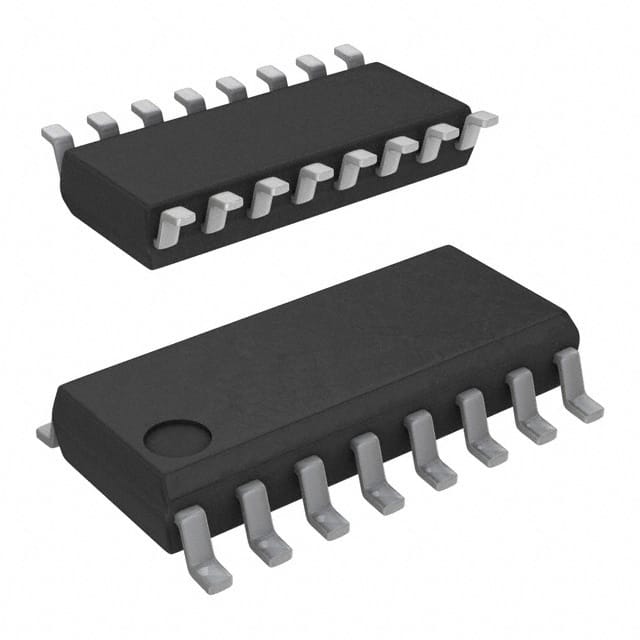CD74ACT109ME4
Basic Information Overview
- Category: Integrated Circuit (IC)
- Use: Digital Logic Device
- Characteristics: Dual J-K Positive-Edge-Triggered Flip-Flop
- Package: SOIC-16
- Essence: High-speed, low-power consumption flip-flop
- Packaging/Quantity: Tape and Reel, 2500 units per reel
Specifications
- Supply Voltage Range: 4.5V to 5.5V
- Input Voltage Range: 0V to VCC
- Operating Temperature Range: -40°C to +85°C
- Output Drive Capability: ±24mA at 4.5V
- Propagation Delay Time: 6ns (typical)
Detailed Pin Configuration
- CLR (Clear) - Active Low Clear Input
- CLK (Clock) - Clock Input
- K1 (J-K Data Input 1)
- J1 (J-K Data Input 1)
- Q1 (Flip-Flop 1 Output)
- Q1̅ (Complementary Output of Flip-Flop 1)
- GND (Ground)
- Q2̅ (Complementary Output of Flip-Flop 2)
- Q2 (Flip-Flop 2 Output)
- J2 (J-K Data Input 2)
- K2 (J-K Data Input 2)
- PRE (Preset) - Active Low Preset Input
- PR̅E (Complementary Input of Preset)
- VCC (Supply Voltage)
- D (Data) - Direct Data Input
- Q (Flip-Flop Output)
Functional Features
- Dual J-K positive-edge-triggered flip-flop with clear and preset capabilities
- High-speed operation suitable for various digital applications
- Low power consumption for energy-efficient designs
- Wide operating voltage range for flexibility in different systems
- Output drive capability allows direct connection to other logic devices
Advantages and Disadvantages
Advantages: - High-speed operation enables efficient data processing - Low power consumption contributes to energy savings - Dual flip-flop design provides versatility in circuit implementation - Wide operating voltage range accommodates different system requirements
Disadvantages: - Limited output drive capability may require additional buffering for certain applications - Clear and preset inputs are active low, which may require level shifting in some cases
Working Principles
The CD74ACT109ME4 is a dual J-K positive-edge-triggered flip-flop. It operates based on the clock input (CLK) and the J-K data inputs (J1, K1, J2, K2). On each rising edge of the clock signal, the flip-flops latch the data present at the J and K inputs. The outputs (Q1, Q1̅, Q2, Q2̅) reflect the latched data after a small propagation delay.
The clear input (CLR) and preset input (PRE) allow for resetting or setting the flip-flop outputs to specific states. When the clear input is activated (low), both flip-flop outputs are forced to logic low. Conversely, when the preset input is activated (low), both outputs are set to logic high.
Detailed Application Field Plans
The CD74ACT109ME4 can be used in various digital applications, including but not limited to: - Sequential logic circuits - Counters and dividers - State machines and control units - Data storage and retrieval systems - Synchronous communication interfaces
Detailed and Complete Alternative Models
Some alternative models that offer similar functionality to the CD74ACT109ME4 include: - SN74ACT109: Similar dual J-K flip-flop in DIP-16 package - CD4013: Dual D-type flip-flop with set and reset capabilities - 74HC109: Dual positive-edge-triggered J-K flip-flop with clear and preset inputs
These alternative models can be considered based on specific design requirements and availability.
Word count: 446 words
Lista 10 Vanliga frågor och svar relaterade till tillämpningen av CD74ACT109ME4 i tekniska lösningar
Sure! Here are 10 common questions and answers related to the application of CD74ACT109ME4 in technical solutions:
Q: What is CD74ACT109ME4? A: CD74ACT109ME4 is a dual positive-edge-triggered JK flip-flop integrated circuit (IC) that can be used in various digital applications.
Q: What is the operating voltage range for CD74ACT109ME4? A: The operating voltage range for CD74ACT109ME4 is typically between 4.5V and 5.5V.
Q: What is the maximum clock frequency supported by CD74ACT109ME4? A: CD74ACT109ME4 can support clock frequencies up to 100 MHz.
Q: How many flip-flops are there in CD74ACT109ME4? A: CD74ACT109ME4 contains two independent flip-flops.
Q: What is the output drive capability of CD74ACT109ME4? A: CD74ACT109ME4 has a typical output drive capability of ±24 mA.
Q: Can CD74ACT109ME4 be used in both synchronous and asynchronous applications? A: Yes, CD74ACT109ME4 can be used in both synchronous and asynchronous applications.
Q: What is the power supply current requirement for CD74ACT109ME4? A: The power supply current requirement for CD74ACT109ME4 is typically around 8 mA.
Q: Does CD74ACT109ME4 have any built-in protection features? A: Yes, CD74ACT109ME4 has built-in electrostatic discharge (ESD) protection on all inputs and outputs.
Q: What is the temperature range within which CD74ACT109ME4 can operate? A: CD74ACT109ME4 can operate within a temperature range of -40°C to +85°C.
Q: What are some typical applications of CD74ACT109ME4? A: CD74ACT109ME4 is commonly used in applications such as counters, frequency dividers, shift registers, and general-purpose flip-flop circuits.
Please note that the answers provided here are general and may vary depending on the specific datasheet and manufacturer's specifications for CD74ACT109ME4.


